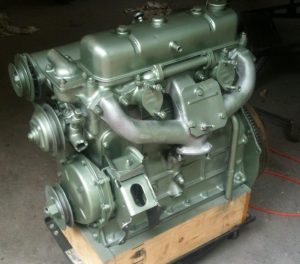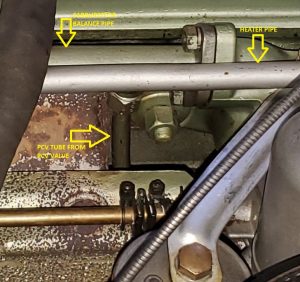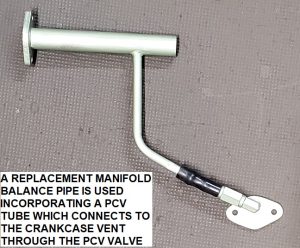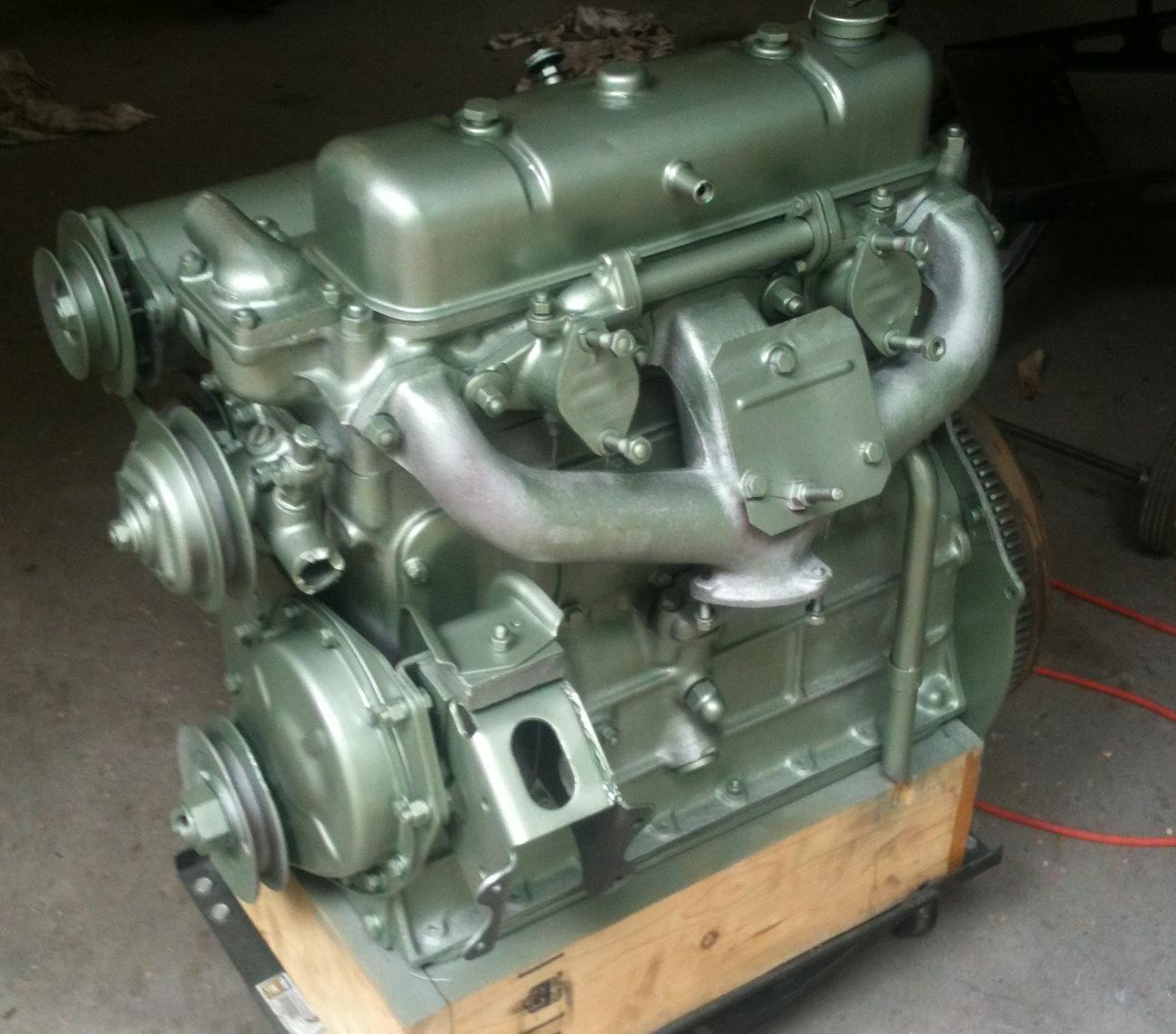When I first got my very early Austin Healey 100, B.#174, on the road after its total frame up restoration I was very pleased that the engine was virtually free of oil leaks however, after a few hundred miles, it started to exhibit the “usual” oil leaks for which these engines are so notorious.  Although the quantity of leakage was relatively small, oil had started to ooze from many places and in particular from the crankshaft rear main seal which on both 4 and 6 cylinder Healey engines is a “scroll’ type seal. I spent quite a bit of time checking all the fasteners and gaskets on the engine but my efforts were mostly in vain.
Although the quantity of leakage was relatively small, oil had started to ooze from many places and in particular from the crankshaft rear main seal which on both 4 and 6 cylinder Healey engines is a “scroll’ type seal. I spent quite a bit of time checking all the fasteners and gaskets on the engine but my efforts were mostly in vain.

After pondering the issue for some time, and frequently cleaning the garage floor, I decided that the root cause of the leakage was crankcase pressure (blow-by) which is quite a normal thing in engines built before the advent of emission controls. Blow-by is caused by the small amount of air that leaks past the piston rings when the engine is running and the method used relieve this pressure in these Austin engines when they were idling was to vent the valve cover and crankcase to one of the air cleaners. The theory behind the air cleaner vent was that the very slight decrease in air pressure resulting from intake air passing through the filter element would be sufficient to draw the blow-by from the crankcase of an idling engine through the carburetors allowing the oil fumes contained within the vented air to be burned as they passed through the cylinders and out the exhaust pipe. To handle the larger volumes of blow-by that are produced when the engine is under load a “road pipe” was installed and this, in of itself, was the source of much of the mess.
Although engines fitted with these systems were reasonably acceptable 60 years ago, these days they would be considered to be gross emitters of pollution.
The first emission control system fitted by manufacturers around 1968 was the Positive Crankcase Ventilation system, PCV. This was achieved by routing all the crankcase blow-by directly into the intake manifold through a PCV valve. The PCV valve regulated the air flow into the intake manifold and prevented any positive pressure which may occur in the intake manifold due to a backfire from finding its way into the crankcase.
One of the unanticipated benefits of these PCV systems was that the slightly lowered pressure in the crankcase resulted in a significant decrease in engine oil leaks because, rather than engine oil oozing out through tiny holes, air would travel into the engine through such holes.
Based upon this I surmised that a PCV system may be a solution to the oil leakage issues of B.#174 however, as the engine was never designed with a PCV system in mind, devising a method of installing such a system took some thought.
After trying several of different prototypes this is the system that I finally devised and installed on the engine in February 2022.
 There are hundreds of different models of PCV valves and after testing several I decided to use one which was all metal, installed in a thread and was designed to operate horizontally and more importantly produced the desired results.
There are hundreds of different models of PCV valves and after testing several I decided to use one which was all metal, installed in a thread and was designed to operate horizontally and more importantly produced the desired results.
The installation of this system required the removal of the carburetors, intake manifold and the engine road-pipe.
After the installation of this system, I connected a primitive manometer to the engine dip stick tube and took the car for a test drive to see how much effect it had on crankcase pressure. The results were quite satisfactory although occasionally, on overrun, very little if any negative pressure was evident in the crankcase so, in order to improve things a little, I installed a plug in the hose which runs from the valve cover to the rear air filter and this resulted in a significant improvement although may not have been necessary.

The result, after a few hundred miles of testing, is that the oil leakage problem was massively improved with virtually nothing leaking from the rear main seal and an engine and engine compartment which stay clean and dry.
There is no question that this has proved to be a very beneficial modification and is highly recommended.
I will be making a small batch of these systems for a few friends who have expressed an interest so, if you would like to try one, let me know.
ADDENDUM
After many inquiries I am purchasing and fabricating all the components required to assemble a small batch of PCV kits for 100 engines. These kits will be be ready for shipping in early April 2023 and will be priced and $USD 185.00 ea including North American shipping. If your 100 has an oil leakage problem caused by engine blow-by this will fix the problem and will be undetectable to all but the most discerning of concours judges. Part # PCVKIT100.
If you would like one of these kits, they will be available in the store in the not too distant future. In the mean time, please email me at michaelsalter@gmail.com with your full mailing address and the quantity required. I will invoice you and get them shipped as soon as possible.


It sounds like your kit works well. I’ve fitted systems to TR3, 4, 6, Sprites and an XK150 using the Wagner two stage pcv valve with great success.
All my systems draw from the top of the engine and all engines had a baffled system to prevent excess oil being drawn into the pcv. I was wondering if you have experienced any additional oil usage by drawing lower down ?
On freshly built engines I fit a filtered fresh air supply to the lower engine, this allows the air to get drawn in as the pcv valve draws from the valve cover. It captures the volatiles and moisture pulling them to the top, prior to burning them.
Without the fresh air supply the air is drawn through any potential leak as your system does. I’ve found that when set up this way, at higher rpm the engine struggles to breathe which cause a power restriction on wide open throttle. Have you noticed this at all ?
I’ve owned my 100-4 since 2001, and have yet to fit a pcv valve, “typical,, I work on other owners cars before mine.”
I received my PCV kit yesterday; the quality of parts and construction was exceptional! I’m not sure when I’ll get a chance to install it, but will report back after I do. I have a PCV system installed on my BJ8 and it has been effective in reducing oil consumption and leakage, without any detrimental effects.
I have my 100 off the road to replace the timing chain and sprockets. While I’m at it I also pulled the induction/exhaust to try and get a handle on my oil leakage problems. I found that the PCV system I rigged up several years ago was not doing the job. After a few hours of trying to find an appropriate valve to match the engine requirements, of which I only had a very vague idea I came across a company called M. E. Wagner who make a dual flow PCV valve (is that redundant?) which they claim is infinitely adjustable to your engine. No other valve is tunable. I have one in hand now and am in the process of installing it. Hope to have the car back on the road next week and I’ll report back. M. E. Wagner is accessible on the internet if anyone is interested.
I spent 12 years rebuilding my 100 having bought a new chassis, a reconditioned engine and lots of boxes of bits. The reconditioned engine wasn’t exactly reconditioned and within a year of being on the road I had bought a new aluminium head and a year later had new liners, pistons and bearings installed. That was over last winter and now I am 900 miles into driving a 100 with a decent engine. During the original restoration I changed the distributor for an electronic type and was very disturbed by the amount of oil that seeped out of it, in fact I was surprised by just how oily the engine was. A friend, who is an expert on 4 cylinder Healeys, here in the UK showed me an article by Michael on PCV valves and so I contacted him. Half a dozen emails later and a kit was delivered to London for my engine.
So, I fitted the kit along with all the other tasks required to get a rebuilt engine up and running after a complete rebuild and started the engine a few months and 900 miles ago. Initially, I did a check with my Gunson Colourtune and the carbs were running well without any required adjustments. The engine runs really well and I am totally in love with the car. And, the engine is clean. There is no, as in none whatsoever, oil coming out of the distributor and is way cleaner than it was.
In summary, after 900 miles the kit, which didn’t cost very much, has significantly reduced oil loss. Would I recommend it, yes, I would.
So glad the PCV kit works for you Steve, I spent many hours coming up with a system which effective and hard to see.
Hi Michael
Do you still have the PCV systems for sale? Is it possible to ship it to Lisbon, Portugal? Cost please.
Thanks Manuel Sanchez
Hi Manuel, I have just received the last of the components for the PCV kits and will have 5 ready for shipping tomorrow.
I will send details as soon as they are ready.
M
Hi Mike,
My wife has a 1953 Austin Healey, I’m in the process of rebuilding the Carbs I was interested in your PCV system and or the PVC information you used for this system.
Hi Edwin, we have made a very small number of “pre production” PCV system components and would be happy to send you one. Please contact me by email and we can make arrangements. michaelsalter@gmail.com
Great post. I’m battling a rear main leak. This mod sounds hopefull for my 55 100 BN1 restoration. Please contact me for purchase.
Hi Donald, please contact me by email …michaelsalter@gmail.com … I am just finishing up a small batch of PCV systems and can provide you with one.